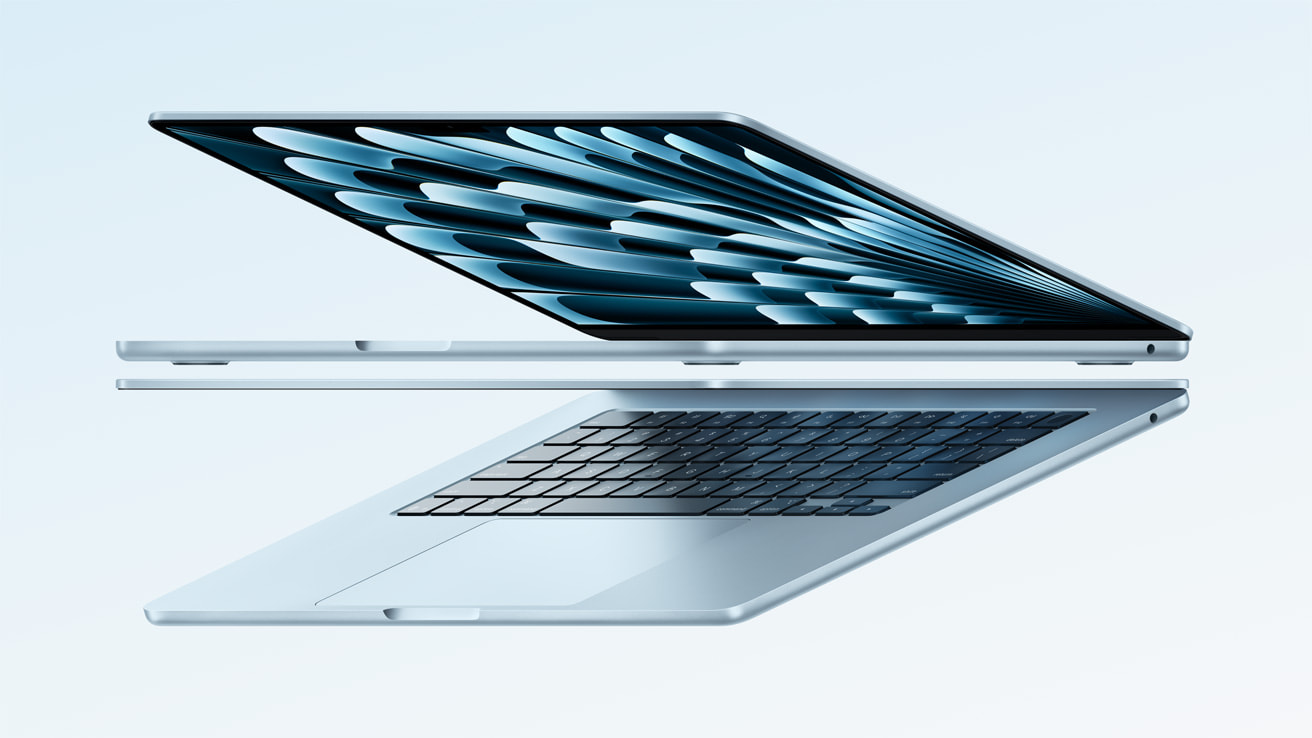A Swift Refresh Redefines Apple’s Entry-Level Laptop
Apple replaced the year-old M3 models on March 5, 2025, by slipping the new M4 chip into the same wafer-thin chassis. The headline? More power, more AI muscle, and a lower starting price—$999 for the 13-inch and $1,199 for the 15-inch. For shoppers who skipped the M3 (or still cling to Intel), the Air just became the best value in the entire Mac lineup.

Silicon That Punches Above Its Weight
The 10-core M4 (four performance + six efficiency cores) rides a second-generation 3 nm process, delivering up to twice the CPU throughput of the M1 and roughly 50 percent more single-core muscle than the M2. GPU improvements are subtler on paper—still “up to” ten cores—but architectural tweaks and higher clocks mean real-world graphics scores creep past last year’s M3 Pro.

An AI-First Neural Engine
Apple pushed the 16-core Neural Engine to 38 trillion operations per second, three times the M1’s pace. That matters because macOS Sequoia leans heavily on on-device “Apple Intelligence”: sentence rewriting in Mail, private local image generation in Messages, and Keynote slide-layout suggestions all run without touching the cloud.
Early reviewers loaded 32-billion-parameter LLMs like DeepSeek R1 into an Air with 32 GB of unified memory—still totally fanless.

MacBook Air M4 Specifications
Here’s a detailed spec sheet for both 13‑inch and 15‑inch MacBook Air M4 models:
| Category | 13″ MacBook Air M4 | 15″ MacBook Air M4 |
|---|---|---|
| Chip | Apple M4 – 10‑core CPU (4P + 6E) with 8‑ or 10‑core GPU, 16‑core Neural Engine, 120 GB/s memory bandwidth | Same as 13″: Apple M4 – 10‑core CPU, 8‑ or 10‑core GPU, 16‑core Neural Engine, 120 GB/s |
| Memory (RAM) | 16 GB base (configurable to 24 or 32 GB LPDDR5X 7500 MT/s) | Same configuration options: 16, 24, or 32 GB |
| Storage | 256 GB base, configurable to 512 GB, 1 TB or 2 TB SSD | 512 GB base, upgradable to 1 TB or 2 TB |
| Display | 13.6″ Liquid Retina IPS, 2560×1664, 224 ppi, 500 nits, P3 wide color, True Tone | 15.3″ Liquid Retina IPS, 2880×1864, 224 ppi, 500 nits, P3, True Tone |
| Camera | 12 MP Center Stage with Desk View and advanced image signal processor | Same 12 MP Center Stage camera |
| Audio | Four-speaker system with Dolby Atmos, three-mic array with beamforming including Voice Isolation | Identical audio setup |
| Ports | 2× Thunderbolt 4 (USB‑C 4) with DisplayPort & charging, MagSafe 3, 3.5 mm headphone jack | Same port layout |
| Wireless | Wi‑Fi 6E (802.11ax), Bluetooth 5.3 | Same wireless specs |
| Battery | 53.8 Whr Li‑Poly; up to 18 hr video playback, ~15 hr wireless web; 20 hr claimed max | 66.5 Whr Li‑Poly; similar endurance estimates (~18 hr) |
| Dimensions & Weight | ~12.31 × 8.71 × 0.44″ (31.26 × 22.13 × 1.13 cm); weight ~1.24 kg (2.73 lb) | 13.4 × 9.5 × 0.4″; weight 3.3 lb (1.5 kg) |
| Colors | Sky Blue, Midnight, Starlight, Silver | Same four finishes |
| Price (USD) | Starts at US $999 (8‑core GPU); 10‑core GPU variant starts at $1,199 | Starts at US $1,199 (10‑core GPU) |
Quick Highlights
- Power: 10‑core CPU/8‑10 core GPU, 16‑core Neural Engine – blazing-fast in daily tasks and still fanless.
- Display & Cameras: Larger, brighter Liquid Retina screens; iPad-grade 12 MP Center Stage front camera with Desk View.
- Memory & Storage: Minimum 16 GB RAM—no more painful upgrades later; up to 2 TB SSD.
- Connectivity: Dual 6K external display support via TB4 ports; MagSafe charging frees up ports.
- Battery Life: Industry-leading longevity—up to 20 hours claimed, ~18 hours in real-world tests.
Triple-Display Support & Everyday Quality-of-Life Gains
- Display output: Two external 6K monitors at 60 Hz while the lid stays open—finally erasing the Air’s single-display bottleneck.
- Webcam: A 12 MP Center Stage camera (borrowed from the iPad) keeps presenters centered and unlocks Desk View for overhead demos.
- Colors: Midnight, Starlight, Silver, and the new Sky Blue finish (the latter hides fingerprints far better than Midnight).
- Connectivity: Wi-Fi 6E, Bluetooth 5.3, two Thunderbolt 4 ports, MagSafe 3, and a 3.5 mm jack with high-impedance headphone support.
- Media engine: Hardware AV1 decode/encode joins ProRes, slashing export times in Final Cut and DaVinci Resolve.
Battery Life & Thermals
Despite the faster silicon, battery benchmarks still hover around 18 hours of continuous video playback and 15 hours of mixed web use. The chassis remains entirely fanless; under a Cinebench loop the chip hits the same peak scores as the M3 Pro-equipped 14-inch MacBook Pro before settling a modest 5–7 percent lower once heat saturates the aluminum shell.
Benchmarks in the Wild
| Test (13-inch, 16 GB) | M4 Air | M3 Air | Snapdragon X Elite (ref) | Intel Lunar Lake Ultra 7 (ref) |
|---|---|---|---|---|
| Geekbench 6 Single | 3,350 | 2,750 | 3,180 | 3,220 |
| Geekbench 6 Multi | 13,200 | 9,700 | 14,100 | 13,500 |
| Cinebench 2024 Multi | 1,230 | 820 | 1,260 | 1,190 |
| Web-based AI Infer. | 1.5 × M3 | 1.0 | 1.2 | 1.1 |
Numbers show Apple keeping pace with next-gen Windows-on-Arm while drawing less than 20 W at the wall.
Who Should Upgrade?
- Intel or M1 Air owners: Night-and-day leap in speed, camera quality, display output, and battery life—an easy yes.
- M2 users: Gains are noticeable but not life-changing; consider trading in only if dual-monitor support or AI workflows matter.
- M3 users: Stick tight. The step from M3 to M4 is evolutionary, not revolutionary, unless you crave Sky Blue or need those extra displays.
The Bottom Line
The MacBook Air M4 blurs the gap between “entry-level” and “pro” more than any previous model. It outpaces last year’s M3 Pro in many everyday tasks, stays silent under pressure, and starts at a price that undercuts comparable Windows Ultrabooks. For most people—students, creative pros on the go, and anyone who values portability over ports—it’s the laptop to beat in 2025.
Macbook Air M3 Info
The MacBook Air lineup received a notable refresh with the launch of Apple’s M4-powered models in March 2025, replacing the previous M3 generation as the company’s latest thin-and-light offering. Available in both 13-inch and 15-inch sizes, the M4 MacBook Air introduces improvements in performance, battery life, and camera quality, while continuing to build on the minimalist design and fanless engineering that define the Air series.

While the M3 MacBook Air models—first released on March 4, 2024—were praised for their speed and efficiency, they’ve now taken a back seat to the M4 lineup. The M4 chip, built on Apple’s second-generation 3nm architecture, delivers better performance-per-watt and enhances tasks ranging from creative workflows to daily productivity. Apple also added a new Sky Blue color option and upgraded the webcam to a 12MP ultra-wide sensor with Center Stage support.
As of mid-2025, the M3 MacBook Air is still a highly capable and recommended laptop, particularly for those looking for excellent battery life, a premium design, and strong performance for everyday tasks and even some more demanding workloads. However, it’s important to note that Apple released the M4 MacBook Air in March 2025, which has become the new flagship for most users.
Here’s a breakdown of the M3 MacBook Air’s standing in 2025:
Latest on MacBook Air M3 Info:
- Chip: The M3 chip features an 8-core CPU (4 performance, 4 efficiency) and either an 8-core or 10-core GPU, along with a 16-core Neural Engine. It offers hardware-accelerated ray tracing and a robust Media Engine.
- Design: The M3 MacBook Air maintains the sleek, fanless, and lightweight design introduced in 2022. It’s available in 13-inch and 15-inch models.
- Display: Both sizes feature a Liquid Retina display (13.6-inch with 2560 x 1664 resolution, 15.3-inch with 2880 x 1864) with P3 wide color gamut and up to 500 nits of brightness.
- Battery Life: Apple claims up to 18 hours of Apple TV app movie playback and 15 hours of wireless web Browse, and reviews confirm it delivers exceptional endurance.
- Ports: It includes two Thunderbolt/USB 4 ports and a MagSafe 3 charging port.
- Connectivity: Supports Wi-Fi 6E and Bluetooth 5.3.
- Sustainability: Apple emphasizes its commitment to recycled materials, with the M3 MacBook Air featuring 100% recycled aluminum in the enclosure and significant amounts of recycled tin, gold, rare earth elements, and cobalt in other components.
- Availability: While no longer sold directly by Apple as the latest model, the M3 MacBook Air is widely available from third-party retailers, often at discounted prices.
How the M3 MacBook Air Stacks Up in 2025:
The arrival of the M4 MacBook Air has shifted the landscape, but the M3 remains a strong contender, especially as a “best budget MacBook” option:
Pros of the M3 MacBook Air in 2025:
- Excellent Performance: The M3 chip still delivers impressive speed for daily tasks, productivity, web Browse, light to moderate video editing, and even some casual gaming. It’s a significant upgrade over Intel-based Macs and even the M1/M2 for many users.
- Outstanding Battery Life: Its exceptional battery endurance continues to be a major selling point, easily lasting a full workday or more.
- Premium Design and Build Quality: The fanless, thin, and light aluminum chassis is still highly regarded for its portability and aesthetics.
- Great Display, Speakers, and Keyboard: The Liquid Retina display is vibrant and sharp, the speakers offer surprisingly rich audio, and the Magic Keyboard and Force Touch trackpad provide a comfortable user experience.
- Value: With the M4 out, the M3 MacBook Air can often be found at a significant discount, making it a highly attractive option for budget-conscious buyers.
- External Display Support: The M3 MacBook Air supports two external displays, but only when the laptop lid is closed.
Cons/Considerations for the M3 MacBook Air in 2025:
- M4 is Newer and Faster: The M4 chip offers incremental performance gains, particularly in graphics and neural engine capabilities. If you need the absolute latest and greatest, the M4 is the way to go.
- Base RAM (8GB): While 8GB of unified memory is sufficient for many, for more demanding multitasking or future-proofing, 16GB or more is recommended. Some M3 configurations did ship with 16GB standard later in its lifecycle.
- Limited Ports: Like its predecessors, the M3 Air only has two Thunderbolt/USB-C ports, which can be restrictive for users with many peripherals.
- External Display Limitation: The M3 MacBook Air requires the lid to be closed to support two external displays, whereas the M4 Air can support two external displays with the lid open.
- No Active Cooling: Being a fanless design, the M3 Air can experience thermal throttling under sustained heavy workloads, which might affect performance for long video renders or intense gaming sessions. For consistently demanding tasks, a MacBook Pro with active cooling is generally preferred.
- No Face ID: Unlike iPhones and iPads, the MacBook Air still relies on Touch ID for biometric authentication.
Comparison with Competitors (including the M4 MacBook Air and Windows laptops):
- M4 MacBook Air: The M4 is the direct successor, offering slightly better performance, an upgraded 12-megapixel Center Stage webcam, and the ability to connect two external displays with the lid open. For most users, the performance difference is minor, so the M3 at a discount remains a strong value proposition.
- MacBook Pro (M4/M4 Pro/M4 Max): For professionals and users with highly demanding workflows (e.g., intensive video editing, 3D rendering), the MacBook Pro models with their more powerful chips (M4 Pro, M4 Max), active cooling, superior displays (ProMotion, higher brightness), and more ports (HDMI, SD card slot) are still the clear winners.
- Windows Laptops: Many ultraportable Windows laptops, especially those with Intel’s latest chips or Snapdragon X Elite, offer fierce competition in terms of performance and features. Some Windows laptops might offer higher refresh rate OLED displays, and a wider variety of ports. However, the M3 MacBook Air generally still holds an edge in battery life and silent operation due to its fanless design and power-efficient Apple Silicon. Compatibility with specific Windows-only software remains a factor for some users.
In summary: The M3 MacBook Air in 2025 is an excellent laptop for the vast majority of users, offering a fantastic balance of performance, battery life, portability, and design. If you can find it at a good price, especially with 16GB of RAM, it’s still a highly recommended purchase for students, everyday productivity, and light creative work. However, if you need the absolute latest performance, improved webcam features, or simultaneous dual external display support with the lid open, the M4 MacBook Air is the more current and slightly more capable option.
Key Takeaways
- The MacBook Air M4 launched in March 2025, superseding the M3 models with enhanced power efficiency and AI-related performance.
- The M4 features support for up to two external displays, a 12MP Center Stage camera, and faster memory bandwidth.
- While the M3 is still available from select retailers at reduced prices, Apple no longer lists it as part of its current MacBook Air lineup.
What Happened to the MacBook Air M3?
The MacBook Air M3, launched in March 2024, was a significant step up from the M2 generation. Built with Apple’s first-generation 3nm chip, it offered improved CPU and GPU performance, 18-hour battery life, and support for dual external displays. It was the first MacBook Air to come in both 13-inch and 15-inch sizes with the same internal specs.
Now that the M4 version is available, Apple has phased out the M3 from its store. However, the M3 MacBook Air remains an excellent value in mid-2025 for those who find it on sale, often priced hundreds of dollars below the M4 models. Its performance still exceeds most users’ everyday needs, making it a solid choice for students, professionals, and creatives who don’t require the absolute latest chip.
In short, the MacBook Air M3 helped pave the way for Apple’s current-generation silicon, and though it’s no longer the newest, it’s still a highly capable machine in the MacBook lineup—especially when purchased at a discount.







